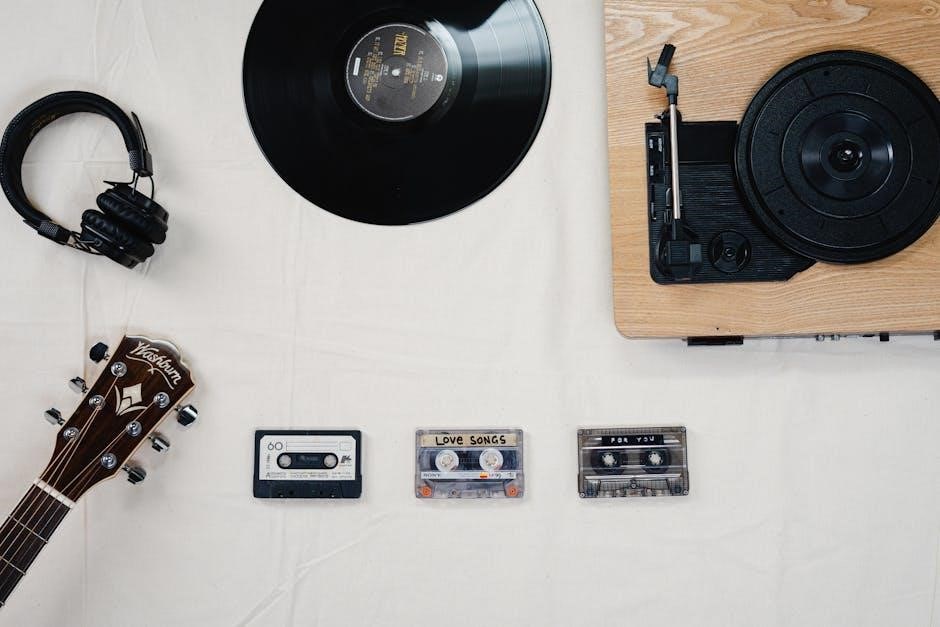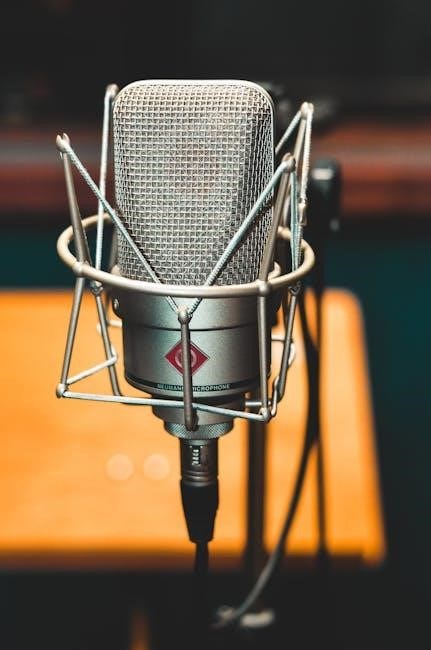The Goldmine Record Guide is a trusted resource for vinyl collectors, providing detailed grading standards, pricing insights, and expert advice for buying, selling, and maintaining records.
What is the Goldmine Record Guide?
The Goldmine Record Guide is a comprehensive resource designed for vinyl enthusiasts, collectors, and sellers. It provides standardized methods for evaluating record condition, determining accurate pricing, and understanding market trends. The guide is widely recognized for its detailed grading system, which helps assess the quality of vinyl records, from mint to poor condition. It also offers insights into factors affecting a record’s value, such as rarity, demand, and historical significance. Whether you’re a seasoned collector or a new enthusiast, the Goldmine Record Guide serves as an essential tool for making informed decisions when buying or selling vinyl. Its expertise helps ensure fairness and transparency in every transaction.
Importance of the Goldmine Record Guide for Vinyl Collectors
Importance of the Goldmine Record Guide for Vinyl Collectors
The Goldmine Record Guide is indispensable for vinyl collectors, offering a standardized framework to evaluate records’ condition and value. It ensures consistency in grading, helping collectors and sellers communicate effectively. By providing clear criteria, it reduces subjectivity in assessments, fostering trust and fairness in transactions. The guide also aids in identifying rare or high-value records, empowering collectors to make informed purchasing decisions; Additionally, it serves as a valuable educational tool, helping newcomers understand the nuances of vinyl collecting. Its influence extends beyond individual collectors, supporting the broader vinyl community by maintaining market integrity and promoting knowledgeable buying and selling practices.

History of Goldmine Record Guide
The Goldmine Record Guide was established in the 1970s as a trusted resource for vinyl collectors, evolving into a comprehensive guide for grading and valuing records.
Origins and Evolution of the Guide
The Goldmine Record Guide traces its origins to the 1970s, emerging as a response to the growing need for standardized vinyl evaluation. Initially, it focused on creating a consistent grading system to help collectors and sellers assess record condition accurately. Over the years, the guide expanded to include detailed pricing information, reflecting market trends and collector demand. Its evolution has been marked by continuous updates, incorporating new methodologies and technologies to remain relevant in the ever-changing world of vinyl collecting. Today, it stands as an indispensable tool, bridging the gap between enthusiasts and the vinyl market’s complexities.
Key Milestones in the Development of the Guide
The Goldmine Record Guide has marked several significant milestones since its inception. Its first publication in the 1970s laid the foundation for standardized vinyl grading. The 1980s saw the introduction of its iconic grading system, which became a benchmark for collectors. In the 1990s, the guide expanded to include pricing data, reflecting the growing market for rare records. The 2000s brought digital integration, making the guide accessible online. Recent years have seen updates to address modern collecting trends, such as the resurgence of vinyl and the rise of online marketplaces. These milestones highlight the guide’s adaptability and enduring relevance in the vinyl community.

Understanding the Goldmine Grading System
The Goldmine Grading System provides a standardized method for evaluating vinyl records, helping collectors and sellers assess condition and determine value accurately.
Overview of the Grading Scale
The Goldmine Grading System offers a detailed scale to evaluate vinyl records, ranging from Mint (perfect condition) to Poor (severe wear). Grades include Near Mint, Very Good+, Very Good, Good, and Fair, each with specific criteria. The scale considers factors like surface scratches, playability, cover condition, and labels. Mint records are flawless, while Poor records may skip or have significant damage. This standardized system helps collectors and sellers communicate effectively, ensuring consistency in assessments. By providing clear guidelines, the Goldmine Grading Scale enhances transparency and fairness in valuing records. It’s an essential tool for anyone serious about vinyl collecting or selling.
How to Accurately Grade Your Vinyl Records
Accurately grading vinyl records requires a meticulous process. Start by inspecting the record under bright light to identify scratches, scuffs, or warping. Play the record to assess sound quality, noting skips, crackling, or surface noise. Check the cover for wear, creases, or damage. Use the Goldmine grading scale as a reference, assigning grades like Mint, Near Mint, or Very Good based on condition. Clean the record before evaluation to ensure accuracy. Consider the label’s condition and any writing or stickers. For consistency, grade the record and cover separately. Finally, compare your findings with the Goldmine Guide to ensure an objective and fair assessment. This method ensures reliability for buyers and sellers alike.

Condition Assessment of Vinyl Records
Condition assessment involves evaluating both the record and cover for flaws like scratches, warping, or wear. The Goldmine Guide provides detailed criteria to determine accurate grades effectively.
Factors Affecting Record Condition
Several factors influence the condition of vinyl records, including storage conditions, handling practices, and environmental exposure. Improper storage, such as stacking records or exposing them to heat, can cause warping or cracking. Handling practices, like touching the playing surface or using dirty needles, can lead to scratches or wear. Environmental factors, such as humidity and temperature fluctuations, may result in mold growth or degradation of the vinyl. Additionally, the quality of the record’s packaging, like the sleeve or cover, plays a role in protecting the record from dust and damage. The Goldmine Record Guide provides detailed criteria to assess these factors accurately, ensuring collectors can maintain and preserve their records effectively.
Common Flaws and Their Impact on Value
Common flaws such as scratches, surface noise, and warping significantly impact a record’s value. Scratches, even minor ones, can cause skips or audio distortion, reducing the record’s desirability. Surface noise, like crackling or hissing, can detract from the listening experience. Warping, which occurs due to heat exposure, can render a record unplayable. The Goldmine Record Guide provides detailed grading criteria to assess these flaws, helping collectors and sellers determine a record’s value accurately. Even slight imperfections can lower a record’s grade and price, emphasizing the importance of proper care and storage to maintain condition and preserve value.

Pricing and Valuation of Vinyl Records
The Goldmine Record Guide helps determine vinyl value by grading condition, rarity, and demand, ensuring fair pricing for collectors and sellers.
How to Determine the Value of Your Records
Evaluating your records’ value involves assessing condition, rarity, and demand. Start by inspecting the vinyl and sleeve for flaws, referencing the Goldmine grading system. Research similar records in the Goldmine Price Guide or online marketplaces to gauge demand. Consider factors like the artist’s popularity, album rarity, and historical significance. Limited editions or sealed copies often command higher prices. Use auction sites to see what similar records have sold for recently. For rare or valuable records, professional appraisals can provide accurate valuations. Keep in mind that condition significantly impacts value, so meticulous care and accurate grading are essential for precise valuation.
Factors Influencing the Price of Vinyl
The price of vinyl records is influenced by several key factors, including condition, rarity, and demand. Records in near-mint condition with minimal wear command higher prices, while those with scratches or damage are valued lower. Rarity, such as limited editions or hard-to-find pressings, significantly increases value. Demand plays a crucial role, with popular artists or genres often selling for more. The presence of original sleeves, inserts, or artwork also boosts value. Additionally, historical significance, such as first pressings or signed copies, can elevate prices. Market trends and collector preferences further shape vinyl pricing, making research essential for accurate valuations.

Using the Goldmine Record Guide for Buying and Selling
The Goldmine Record Guide is an indispensable tool for buyers and sellers, offering detailed grading systems, pricing data, and expert tips to ensure fair and informed transactions.
Tips for Buyers: How to Use the Guide Effectively
Buyers can maximize the Goldmine Record Guide by understanding its grading scale and pricing benchmarks. Researching specific records beforehand helps identify fair market values. Always cross-reference listings with the guide to avoid overpaying. Pay attention to condition descriptions, as minor flaws can significantly impact price. Utilize the guide’s authentication tips to ensure records are genuine. Engage with seller communities and forums for additional insights. Prioritize sellers who adhere to the guide’s standards for grading and transparency. By leveraging these strategies, buyers can make informed decisions and build a high-quality vinyl collection with confidence and efficiency.
Strategies for Sellers: Maximizing Your Record’s Value
To maximize your record’s value, ensure accurate grading using the Goldmine Record Guide’s standards. Provide high-quality photos showcasing the record’s condition from multiple angles. Include detailed descriptions of any flaws or wear to build trust with buyers. Research similar listings to price competitively while reflecting the record’s true worth. Highlight rare or unique features, such as limited editions or sealed copies, to attract serious collectors. List records in appropriate categories to reach the right audience. Consider timing your listings during peak vinyl demand, such as holidays or special events. Respond promptly to inquiries to foster positive interactions and secure sales.

Handling and Cleaning Vinyl Records
Proper handling and cleaning are essential for preserving vinyl records. Handle by edges, use a carbon fiber brush for dust, and clean with a microfiber cloth dampened with distilled water, avoiding harsh chemicals.
Best Practices for Maintaining Record Condition
Proper handling and storage are crucial for preserving vinyl records. Always handle records by the edges to avoid fingerprints and scratches. Store them upright in sleeves to prevent warping. Use a carbon fiber brush to remove dust before playback. Clean records gently with a microfiber cloth dampened with distilled water, avoiding harsh chemicals. Avoid exposing records to direct sunlight or extreme temperatures; Store in a cool, dry place, away from humidity. Use high-quality, acid-free sleeves for long-term preservation. Never stack records horizontally, as this can cause bending. Regularly inspect records for damage and address issues promptly to maintain their condition and value. Consistent care ensures optimal playback and lasting enjoyment.
Recommended Cleaning Methods and Tools
Cleaning vinyl records requires gentle yet effective methods to preserve their quality. Start by using a carbon fiber brush to remove surface dust and debris. For deeper cleaning, apply a small amount of distilled water or a specialized record cleaning solution to a microfiber cloth, then gently wipe the record in a circular motion, starting from the outer edge toward the center. Avoid harsh chemicals or abrasive materials that can damage the vinyl. For stubborn stains, consider using a record cleaning machine, which uses suction to remove dirt and grime. Regular cleaning not only improves sound quality but also extends the lifespan of your records. Always handle records by the edges to prevent fingerprints and scratches. Consistent maintenance ensures your collection remains in pristine condition for years to come.

Authentication and Avoiding Counterfeits
Authenticating vinyl records involves examining labels, etchings, and packaging for consistency with known releases. Counterfeits often lack precise details or have inferior materials. Always verify through trusted sources or experts to ensure authenticity and avoid fraudulent purchases in the vinyl market.
How to Identify Genuine Vinyl Records
Identifying genuine vinyl records involves inspecting the label, etchings, and packaging for consistency with known releases. Check for proper alignment of text, accurate color schemes, and authentic logos. Matrix numbers etched into the vinyl’s runoff groove should match the release details. Counterfeit records often lack these precise details or have blurry text. Weigh the record; genuine vinyl typically feels heavier and more durable. Play the record to assess sound quality—authentic pressings usually have superior audio clarity. Use the Goldmine Record Guide to cross-reference these elements, ensuring the record matches its described condition and specifications. This guide helps collectors verify authenticity and avoid counterfeit purchases.
Spotting Counterfeit Records: A Guide
Spotting counterfeit records requires a keen eye for detail. Look for blurry or misaligned labels, uneven text spacing, and low-quality paper or cardboard. Genuine records typically have sharp, vibrant labels with precise alignment. Counterfeit records may lack the weight and durability of authentic vinyl, feeling lighter or more brittle. Inspect the runoff groove for proper etchings and check for inconsistent matrix numbers. Sound quality can also be a giveaway—counterfeit records often produce poor audio. Use the Goldmine Record Guide to compare details like label variations, release dates, and packaging. These steps help collectors avoid purchasing fake records and ensure authenticity in their collection.

Goldmine Record Guide and Collectors Communities
The Goldmine Record Guide serves as a central resource for collectors, fostering connections through forums, events, and shared knowledge, helping build a thriving vinyl collecting culture.
The Role of Goldmine in Vinyl Collecting Communities
The Goldmine Record Guide plays a vital role in uniting vinyl collectors worldwide, offering a shared language for grading, pricing, and evaluating records. By providing standardized criteria, it fosters trust and collaboration among enthusiasts, dealers, and sellers. The guide not only educates newcomers but also serves as a reference for seasoned collectors, ensuring consistency in transactions. Its influence extends beyond individual collections, helping to build and sustain a vibrant, interconnected community. Through forums, events, and resources, Goldmine bridges gaps between collectors, creating opportunities for networking and knowledge exchange that strengthen the vinyl collecting culture globally.
Connecting with Other Collectors and Sellers
Goldmine Record Guide facilitates connections among vinyl enthusiasts, enabling collectors and sellers to network effectively. Through its resources, such as forums and marketplaces, individuals can share knowledge, trade records, and discover rare finds. The guide’s standardized grading system ensures clear communication, building trust in transactions. Workshops and events further foster collaboration, allowing collectors to learn from experts and each other. By bridging the gap between buyers and sellers, Goldmine enhances the overall vinyl collecting experience, creating a robust and interactive community that thrives on shared passion and mutual support. This interconnected network is vital for the growth and sustainability of vinyl culture.

Future of Vinyl Collecting and the Goldmine Record Guide
Vinyl collecting continues to thrive, with the Goldmine Record Guide adapting to emerging trends, ensuring its relevance as a vital resource for collectors in the digital age.
Trends in Vinyl Collecting
Vinyl collecting continues to grow in popularity, driven by nostalgia and a desire for tangible music experiences. Collectors increasingly seek rare and limited-edition records, with a focus on condition and authenticity. The Goldmine Record Guide plays a crucial role in shaping these trends by providing standardized grading and valuation criteria. Younger generations are embracing vinyl, blending traditional collecting with modern digital tools. As demand rises, the guide remains essential for both seasoned collectors and newcomers, offering insights into market trends and best practices. Its adaptability ensures it stays relevant, fostering a vibrant community of vinyl enthusiasts worldwide.
The Role of the Goldmine Record Guide in the Digital Age
Despite the rise of digital music, the Goldmine Record Guide remains indispensable, offering a bridge between physical and digital collecting. It provides detailed grading and valuation standards, essential for online marketplaces. The guide’s adaptability ensures it stays relevant, aiding collectors in verifying authenticity and assessing record condition. By integrating with digital tools, it enhances the vinyl buying and selling experience. Its role in maintaining vinyl’s cultural significance is vital, supporting both traditional and modern collecting practices. As vinyl’s popularity endures, the Goldmine Record Guide continues to be a cornerstone for enthusiasts, ensuring clarity and consistency in the evolving market.
The Goldmine Record Guide is a cornerstone for vinyl enthusiasts, offering essential insights into grading, valuation, and care. Its enduring relevance supports collectors in preserving and appreciating their records.
Final Thoughts on the Goldmine Record Guide
Encouragement to Start or Expand Your Vinyl Collection
Embarking on or expanding your vinyl collection is a rewarding journey, and the Goldmine Record Guide is your ultimate companion. Whether you’re a newcomer or a seasoned collector, this guide equips you with the knowledge to make informed decisions. Discover the thrill of hunting for rare records, the satisfaction of growing your collection, and the joy of connecting with fellow enthusiasts. Vinyl collecting is more than a hobby—it’s a celebration of music, art, and history. Use the Goldmine Record Guide to navigate the world of vinyl with confidence, and let your passion for music shine through your ever-growing collection.
